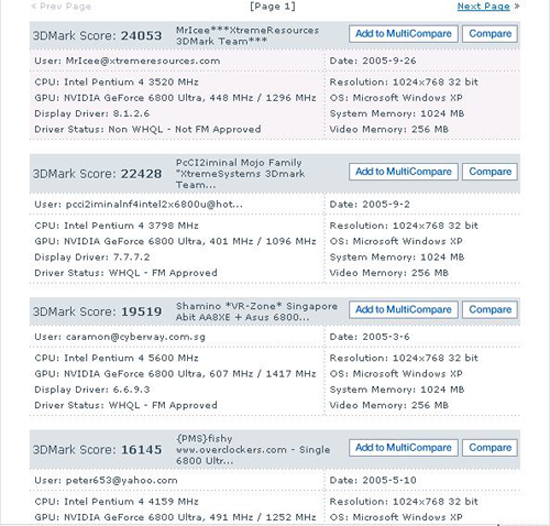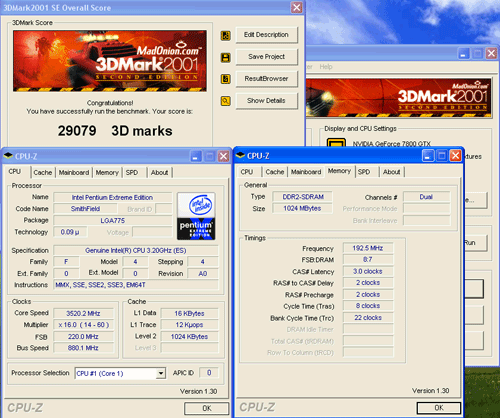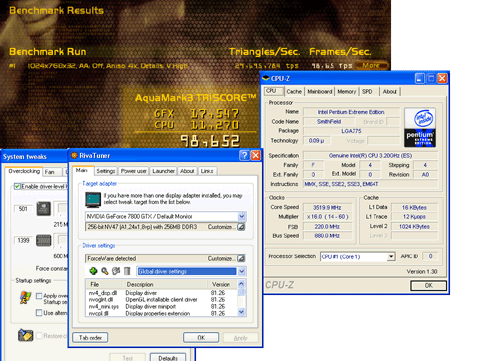Abit NI8 SLI: nVidia SLI for the Intel Gamer
by Randi Sica & Wesley Fink on October 7, 2005 12:05 AM EST- Posted in
- Motherboards
ABIT NI8 SLI - Overclocked 3D benchmark performance + SLI verification
As a measure of the effectiveness of the optimized bandwidth dialed in during testing, competitive 3D benchmarks were run apart from the standard AnandTech suite to determine how well ABIT did their homework toward the gaming end. This has been where they've built their reputation and we "put that reputation on the line". All posted scores reflect the overclocked P4 D840 EE running at 3520 MHz (16x220), memory at 770 MHz 3-2-2-8 1T, and a single 7800GTX run at 500 MHz core/1400Mhz memory, for the first tests. For the second round, we ran a pair of NVIDIA 6800Ultra's (448 MHz core/1296 MHz memory) to also verify proper SLI operation. For these tests only, the NVIDIA beta 81.26 drivers were installed.
First up is a run of 3DMark 2001 utilizing the single NVIDIA 7800GTX. 3DMark 2001 is still widely used because it is the most sensitive of the 3DMark tests to changes in CPU speed and memory bandwidth.
A run of Aquamark 3 was made to assess any performance gains with system and graphics card overclocked in comparison to the standard AnandTech run. We were quite impressed with the substantial numbers produced for a single graphic card run.
The final round found us verifying SLI operation, and verify it, we did. With the addition of a pair of NVIDIA 6800Ultra's using the same beta 81.26 Forceware drivers, we wanted to determine this system's performance relative to other P4/6800Ultra SLI combinations on Futuremark's ORB. It was a pleasant surprise to set new records in both 3DMark 2003 and 2005. As a longtime Captain/member of a competitive 3DMark Team, under the moniker "MrIcee", it was nice to see chart-topping performance with a new Abit board running the Intel version NVIDIA nForce4 SLI chipset.
As a measure of the effectiveness of the optimized bandwidth dialed in during testing, competitive 3D benchmarks were run apart from the standard AnandTech suite to determine how well ABIT did their homework toward the gaming end. This has been where they've built their reputation and we "put that reputation on the line". All posted scores reflect the overclocked P4 D840 EE running at 3520 MHz (16x220), memory at 770 MHz 3-2-2-8 1T, and a single 7800GTX run at 500 MHz core/1400Mhz memory, for the first tests. For the second round, we ran a pair of NVIDIA 6800Ultra's (448 MHz core/1296 MHz memory) to also verify proper SLI operation. For these tests only, the NVIDIA beta 81.26 drivers were installed.
First up is a run of 3DMark 2001 utilizing the single NVIDIA 7800GTX. 3DMark 2001 is still widely used because it is the most sensitive of the 3DMark tests to changes in CPU speed and memory bandwidth.
A run of Aquamark 3 was made to assess any performance gains with system and graphics card overclocked in comparison to the standard AnandTech run. We were quite impressed with the substantial numbers produced for a single graphic card run.
The final round found us verifying SLI operation, and verify it, we did. With the addition of a pair of NVIDIA 6800Ultra's using the same beta 81.26 Forceware drivers, we wanted to determine this system's performance relative to other P4/6800Ultra SLI combinations on Futuremark's ORB. It was a pleasant surprise to set new records in both 3DMark 2003 and 2005. As a longtime Captain/member of a competitive 3DMark Team, under the moniker "MrIcee", it was nice to see chart-topping performance with a new Abit board running the Intel version NVIDIA nForce4 SLI chipset.
3DMark 2003
3DMark 2005












19 Comments
View All Comments
jojo4u - Friday, October 7, 2005 - link
The graphs give a nice overview, good work.Please consider to include the information what AF level was used into the graphs. This is something all recent reviews here have have been lacking.
About the image quality: The shimmering was greatly reduced with the fixed driver (78.03). So it's down to NV40 level now. But 3dCenter.de[1] and Computerbase.de conclude that only enabling "high quality" in the Forceware brings comparable image quality to "A.I. low". Perhaps you find the time to explore this issue in the image quality tests.
[1] http://www.3dcenter.de/artikel/g70_flimmern/index_...">http://www.3dcenter.de/artikel/g70_flimmern/index_...
This article is about the unfixed quality. But to judge the G70 today, have a look at the 6800U videos.
http://www.hexus.net/content/item.php?item=1549&am...">http://www.hexus.net/content/item.php?item=1549&am...
This article shows the performance hit of enabling "high quality"
jojo4u - Friday, October 7, 2005 - link
oops wrong forumAvalon - Friday, October 7, 2005 - link
Thanks for the clarification Wesley, and welcome aboard Randi!Wesley Fink - Friday, October 7, 2005 - link
Please welcome Randi Sica as our newest reviewer at AnandTech. Randi is a friend who is well known in the Extreme Overclocking community as Mr. Icee. That gives Randi a keen eye when looking at what's right and wrong with a motherboard from an Extreme Overclocker's perspective.We think you will also find Randi's review perspective and approach a little different. Those who have been screaming for overclocked benchmarks in board reviews will find them in Randi's reviews.
This is Randi's first review at AnandTech, so please make him feel welcomed.
yacoub - Friday, October 7, 2005 - link
PASSIVELY COOLED! That's soooo appealing. I wish board makers could get the northbridges cool enough on the AMD chipset to make more passively cooled boards. I hate having another fan in the case, especially a tiny one running at high revs making a racket. It's bad enough most GPUs suffer from that, we don't need another one on the mobo. :(DigitalFreak - Friday, October 7, 2005 - link
Correct me if I'm wrong here, but I don't think the audio is on the PCI-E bus. The codec hangs directly off the southbridge, and isn't on any bus. If you look at the slot the audio card goes in, it's actually a PCI-E 1x connector turned backwards. I'm assuming that they use that particular connector because it's cheaper than designing something custom. Still, not a bad job on the CPU utilization.BTW, the chip is an ALC850, not ACL850 as mentioned on page 3.
Wesley Fink - Friday, October 7, 2005 - link
Thanks for pointing this out. The references to the audio connector have been corrected to "dedicated audio connector" which it is unless we hear otherwise from Abit. We have seen the separate dedicated audio card can significantly reduce CPU overhead, and Abit seems to have done well with this idea on this board.Live - Friday, October 7, 2005 - link
Enough said...Avalon - Friday, October 7, 2005 - link
Wait, what? You are comparing a dual core HT enabled system with several other Intel systems using only a single core? How is this apples to apples? This makes all of the benchmarks you did worthless.
Wesley Fink - Friday, October 7, 2005 - link
ALL tests used the exact same CPU except the Workstation test results. That means general performance, encoding, DX9, and DX8 gaming were tested on all reported platforms with the Pentium D 840EE.The Workstation Tests were included because they were an interesting picture of a 3.6GHz single core being soundly outperformed by a 3.2GHz dual-core Pentium D. The workstation tests were meant to be an illustration, not a direct comparison.
The 3.46EE was used in some past memory tests to achieve high memory bus speeds, and the reference was only made in examing overclocked memory FSB speed records - not comparative performance.
We will make this clearer in the review, but all of the benchmarks except Worksation are definitely apples to apples tests - even down to HT being enabled in all tests.